Port Logistics City: A Case Study of Melbourne, Australia
VerifiedAdded on 2022/09/17
|16
|3906
|20
Report
AI Summary
This report examines the port logistics system in Melbourne, Australia, focusing on challenges and potential solutions. The study identifies three major issues: inefficient freight movement in and out of the port, the problem of empty container movement on roads, and a heavy reliance on trucks. The report recommends promoting transloading and cross-docking systems to improve efficiency and reduce costs. It also assesses the feasibility of transloading strategies in other port logistics cities and discusses the advantages and disadvantages of transloading and cross-docking. The report includes a diagram illustrating the benefits of the cargo rotation technique and concludes by summarizing the key findings and recommendations for improving the Melbourne port logistics system.
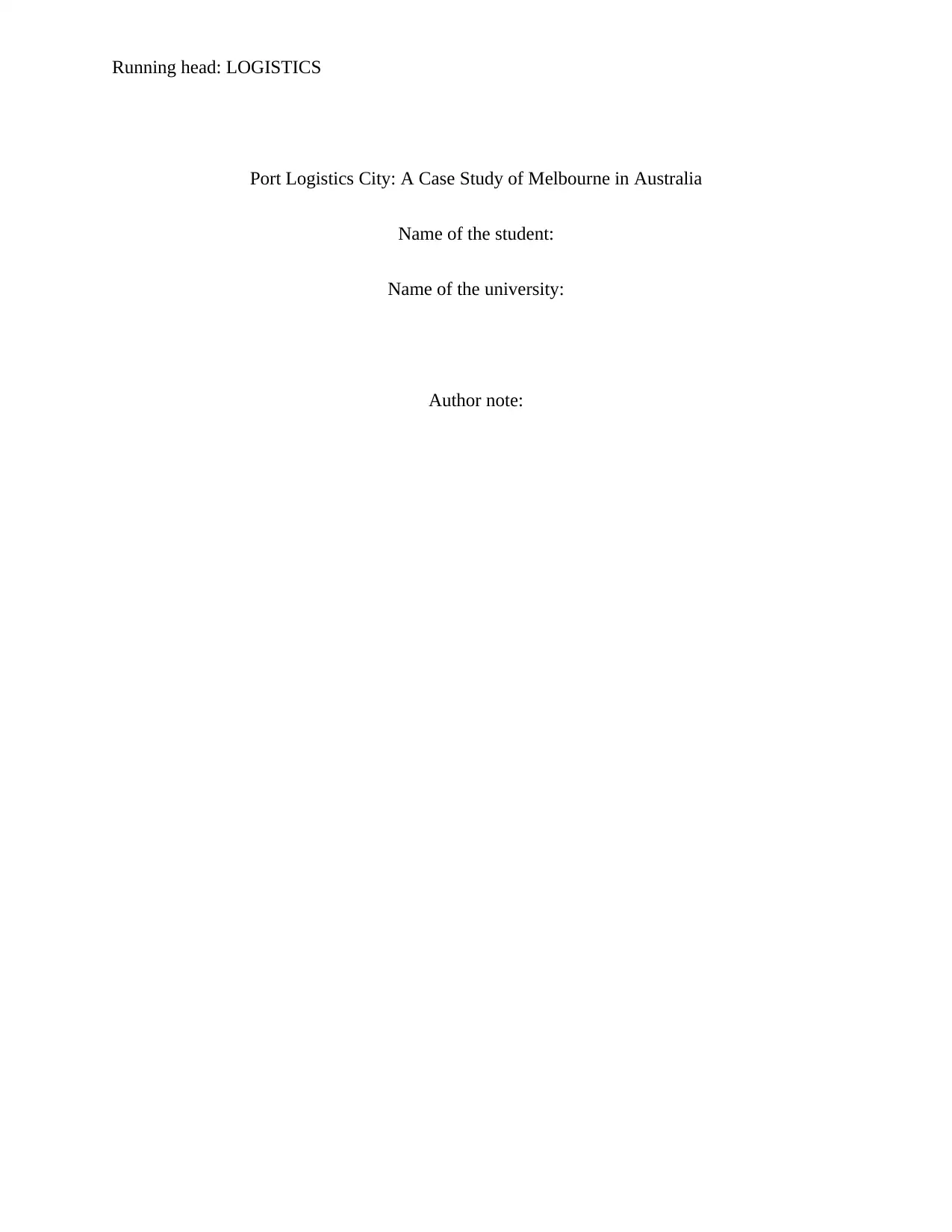
Running head: LOGISTICS
Port Logistics City: A Case Study of Melbourne in Australia
Name of the student:
Name of the university:
Author note:
Port Logistics City: A Case Study of Melbourne in Australia
Name of the student:
Name of the university:
Author note:
Paraphrase This Document
Need a fresh take? Get an instant paraphrase of this document with our AI Paraphraser
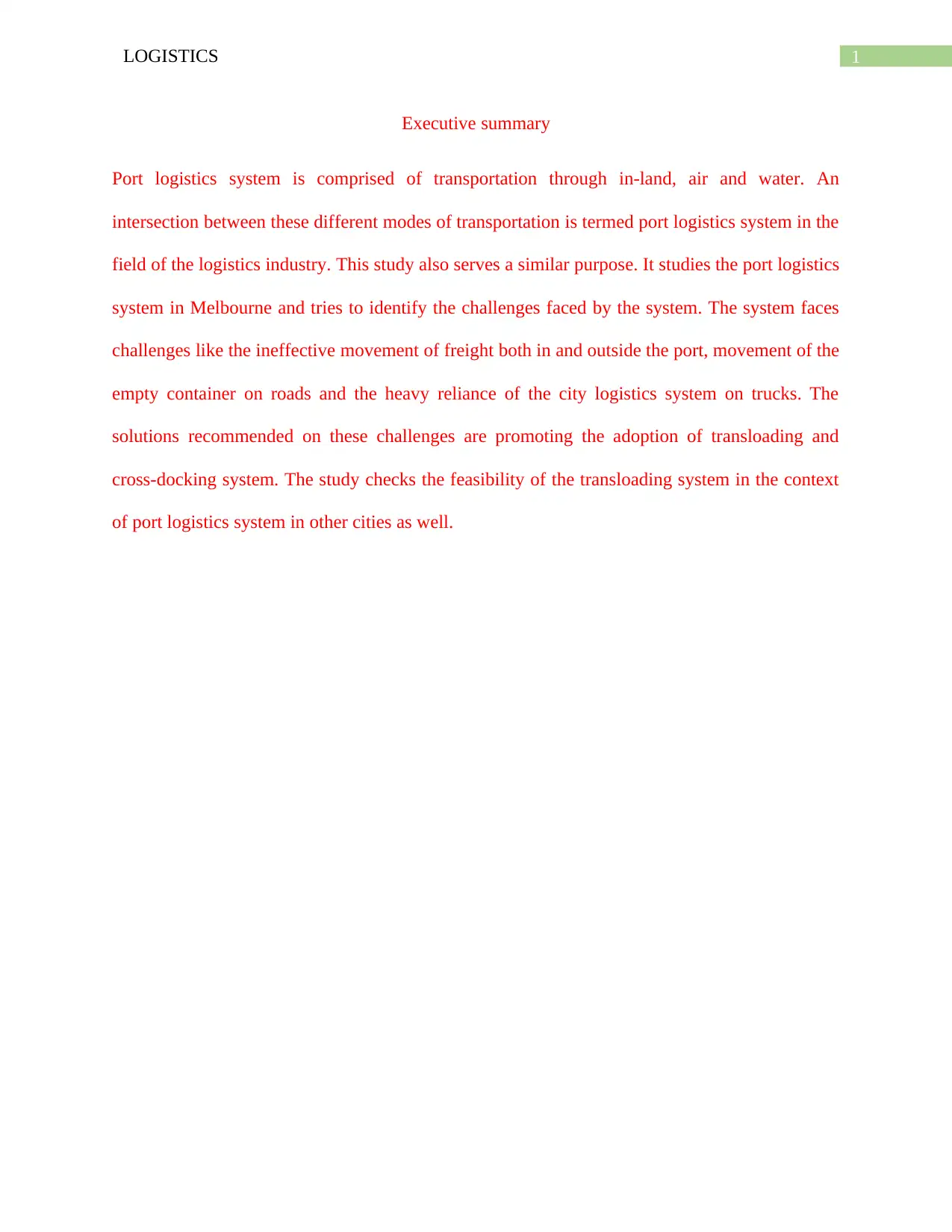
1LOGISTICS
Executive summary
Port logistics system is comprised of transportation through in-land, air and water. An
intersection between these different modes of transportation is termed port logistics system in the
field of the logistics industry. This study also serves a similar purpose. It studies the port logistics
system in Melbourne and tries to identify the challenges faced by the system. The system faces
challenges like the ineffective movement of freight both in and outside the port, movement of the
empty container on roads and the heavy reliance of the city logistics system on trucks. The
solutions recommended on these challenges are promoting the adoption of transloading and
cross-docking system. The study checks the feasibility of the transloading system in the context
of port logistics system in other cities as well.
Executive summary
Port logistics system is comprised of transportation through in-land, air and water. An
intersection between these different modes of transportation is termed port logistics system in the
field of the logistics industry. This study also serves a similar purpose. It studies the port logistics
system in Melbourne and tries to identify the challenges faced by the system. The system faces
challenges like the ineffective movement of freight both in and outside the port, movement of the
empty container on roads and the heavy reliance of the city logistics system on trucks. The
solutions recommended on these challenges are promoting the adoption of transloading and
cross-docking system. The study checks the feasibility of the transloading system in the context
of port logistics system in other cities as well.
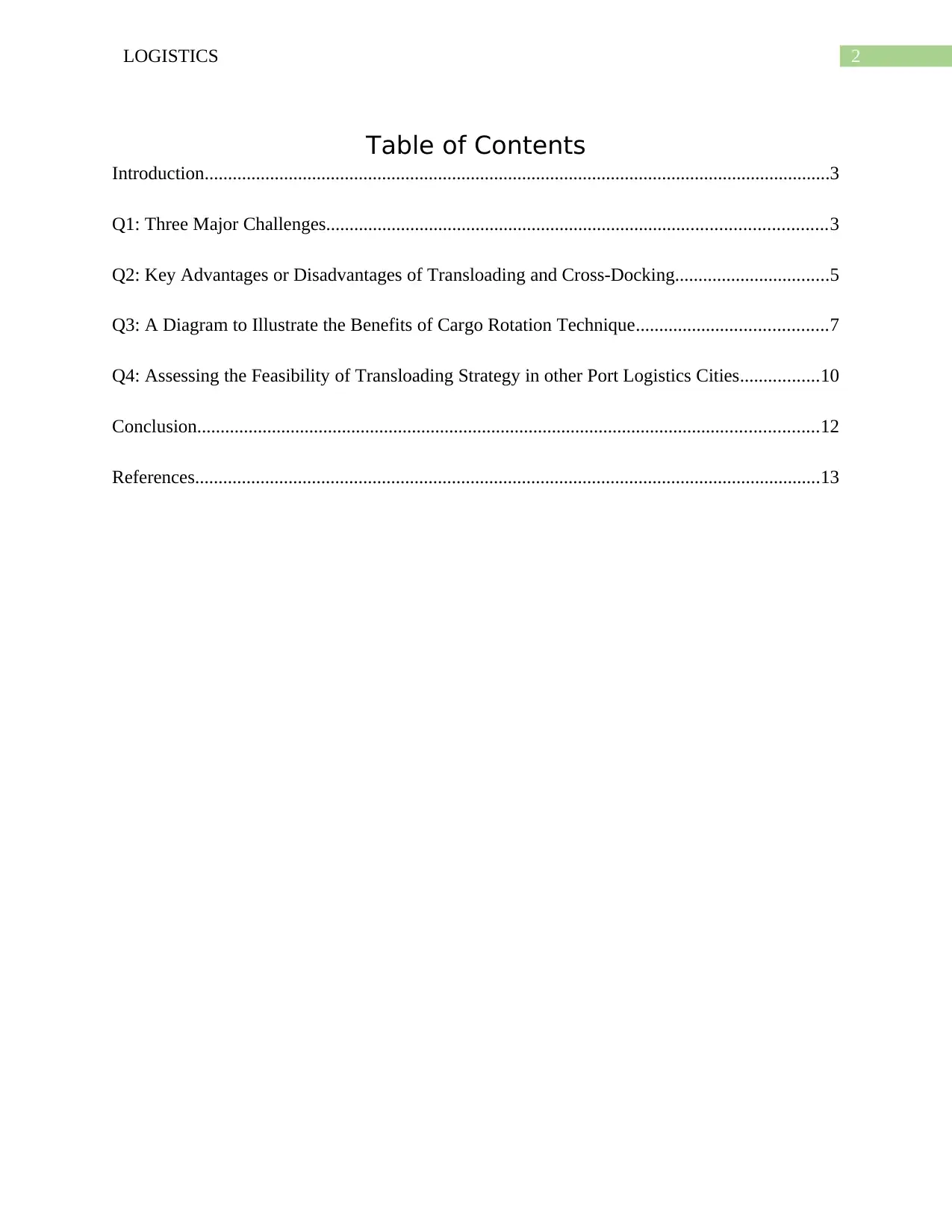
2LOGISTICS
Table of Contents
Introduction......................................................................................................................................3
Q1: Three Major Challenges...........................................................................................................3
Q2: Key Advantages or Disadvantages of Transloading and Cross-Docking.................................5
Q3: A Diagram to Illustrate the Benefits of Cargo Rotation Technique.........................................7
Q4: Assessing the Feasibility of Transloading Strategy in other Port Logistics Cities.................10
Conclusion.....................................................................................................................................12
References......................................................................................................................................13
Table of Contents
Introduction......................................................................................................................................3
Q1: Three Major Challenges...........................................................................................................3
Q2: Key Advantages or Disadvantages of Transloading and Cross-Docking.................................5
Q3: A Diagram to Illustrate the Benefits of Cargo Rotation Technique.........................................7
Q4: Assessing the Feasibility of Transloading Strategy in other Port Logistics Cities.................10
Conclusion.....................................................................................................................................12
References......................................................................................................................................13
⊘ This is a preview!⊘
Do you want full access?
Subscribe today to unlock all pages.

Trusted by 1+ million students worldwide
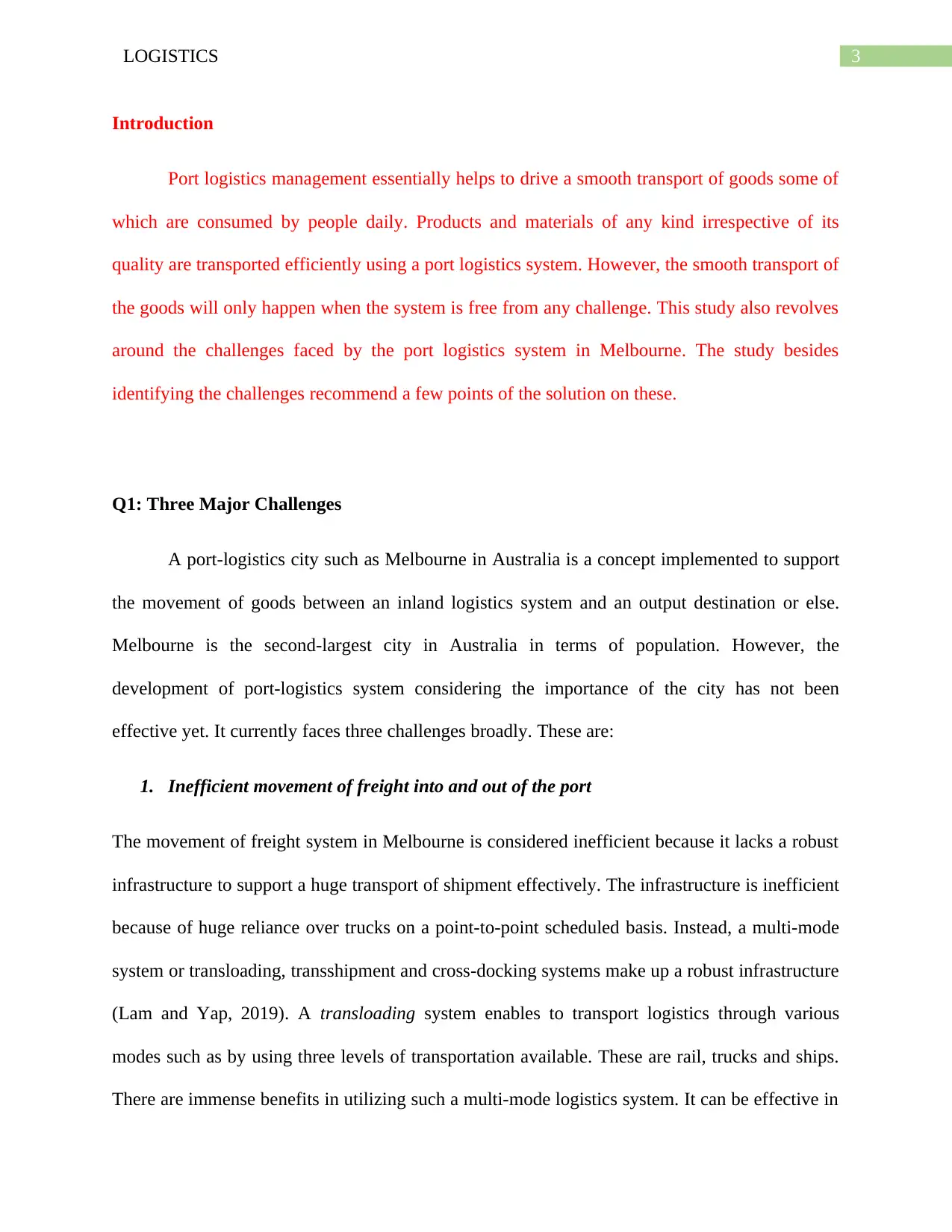
3LOGISTICS
Introduction
Port logistics management essentially helps to drive a smooth transport of goods some of
which are consumed by people daily. Products and materials of any kind irrespective of its
quality are transported efficiently using a port logistics system. However, the smooth transport of
the goods will only happen when the system is free from any challenge. This study also revolves
around the challenges faced by the port logistics system in Melbourne. The study besides
identifying the challenges recommend a few points of the solution on these.
Q1: Three Major Challenges
A port-logistics city such as Melbourne in Australia is a concept implemented to support
the movement of goods between an inland logistics system and an output destination or else.
Melbourne is the second-largest city in Australia in terms of population. However, the
development of port-logistics system considering the importance of the city has not been
effective yet. It currently faces three challenges broadly. These are:
1. Inefficient movement of freight into and out of the port
The movement of freight system in Melbourne is considered inefficient because it lacks a robust
infrastructure to support a huge transport of shipment effectively. The infrastructure is inefficient
because of huge reliance over trucks on a point-to-point scheduled basis. Instead, a multi-mode
system or transloading, transshipment and cross-docking systems make up a robust infrastructure
(Lam and Yap, 2019). A transloading system enables to transport logistics through various
modes such as by using three levels of transportation available. These are rail, trucks and ships.
There are immense benefits in utilizing such a multi-mode logistics system. It can be effective in
Introduction
Port logistics management essentially helps to drive a smooth transport of goods some of
which are consumed by people daily. Products and materials of any kind irrespective of its
quality are transported efficiently using a port logistics system. However, the smooth transport of
the goods will only happen when the system is free from any challenge. This study also revolves
around the challenges faced by the port logistics system in Melbourne. The study besides
identifying the challenges recommend a few points of the solution on these.
Q1: Three Major Challenges
A port-logistics city such as Melbourne in Australia is a concept implemented to support
the movement of goods between an inland logistics system and an output destination or else.
Melbourne is the second-largest city in Australia in terms of population. However, the
development of port-logistics system considering the importance of the city has not been
effective yet. It currently faces three challenges broadly. These are:
1. Inefficient movement of freight into and out of the port
The movement of freight system in Melbourne is considered inefficient because it lacks a robust
infrastructure to support a huge transport of shipment effectively. The infrastructure is inefficient
because of huge reliance over trucks on a point-to-point scheduled basis. Instead, a multi-mode
system or transloading, transshipment and cross-docking systems make up a robust infrastructure
(Lam and Yap, 2019). A transloading system enables to transport logistics through various
modes such as by using three levels of transportation available. These are rail, trucks and ships.
There are immense benefits in utilizing such a multi-mode logistics system. It can be effective in
Paraphrase This Document
Need a fresh take? Get an instant paraphrase of this document with our AI Paraphraser
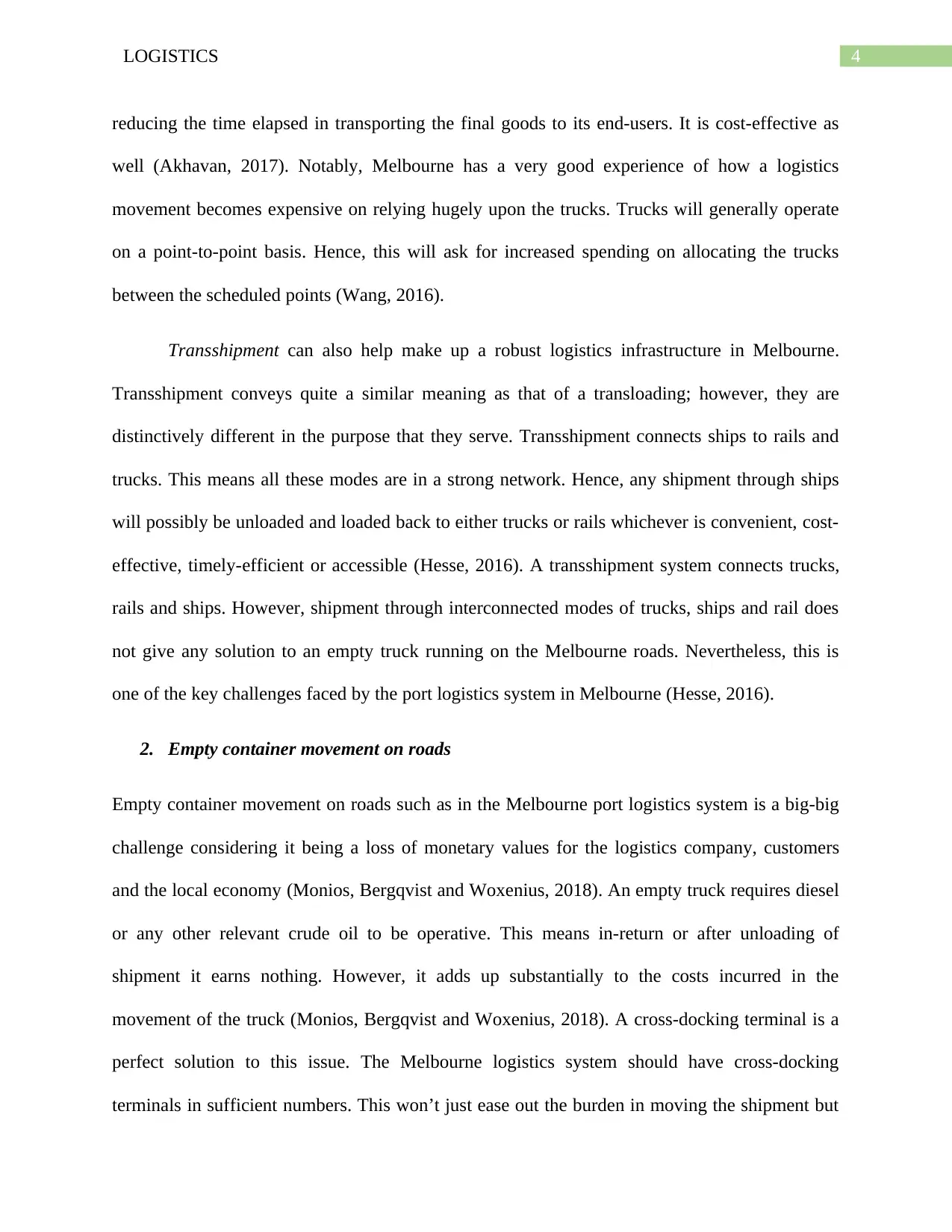
4LOGISTICS
reducing the time elapsed in transporting the final goods to its end-users. It is cost-effective as
well (Akhavan, 2017). Notably, Melbourne has a very good experience of how a logistics
movement becomes expensive on relying hugely upon the trucks. Trucks will generally operate
on a point-to-point basis. Hence, this will ask for increased spending on allocating the trucks
between the scheduled points (Wang, 2016).
Transshipment can also help make up a robust logistics infrastructure in Melbourne.
Transshipment conveys quite a similar meaning as that of a transloading; however, they are
distinctively different in the purpose that they serve. Transshipment connects ships to rails and
trucks. This means all these modes are in a strong network. Hence, any shipment through ships
will possibly be unloaded and loaded back to either trucks or rails whichever is convenient, cost-
effective, timely-efficient or accessible (Hesse, 2016). A transshipment system connects trucks,
rails and ships. However, shipment through interconnected modes of trucks, ships and rail does
not give any solution to an empty truck running on the Melbourne roads. Nevertheless, this is
one of the key challenges faced by the port logistics system in Melbourne (Hesse, 2016).
2. Empty container movement on roads
Empty container movement on roads such as in the Melbourne port logistics system is a big-big
challenge considering it being a loss of monetary values for the logistics company, customers
and the local economy (Monios, Bergqvist and Woxenius, 2018). An empty truck requires diesel
or any other relevant crude oil to be operative. This means in-return or after unloading of
shipment it earns nothing. However, it adds up substantially to the costs incurred in the
movement of the truck (Monios, Bergqvist and Woxenius, 2018). A cross-docking terminal is a
perfect solution to this issue. The Melbourne logistics system should have cross-docking
terminals in sufficient numbers. This won’t just ease out the burden in moving the shipment but
reducing the time elapsed in transporting the final goods to its end-users. It is cost-effective as
well (Akhavan, 2017). Notably, Melbourne has a very good experience of how a logistics
movement becomes expensive on relying hugely upon the trucks. Trucks will generally operate
on a point-to-point basis. Hence, this will ask for increased spending on allocating the trucks
between the scheduled points (Wang, 2016).
Transshipment can also help make up a robust logistics infrastructure in Melbourne.
Transshipment conveys quite a similar meaning as that of a transloading; however, they are
distinctively different in the purpose that they serve. Transshipment connects ships to rails and
trucks. This means all these modes are in a strong network. Hence, any shipment through ships
will possibly be unloaded and loaded back to either trucks or rails whichever is convenient, cost-
effective, timely-efficient or accessible (Hesse, 2016). A transshipment system connects trucks,
rails and ships. However, shipment through interconnected modes of trucks, ships and rail does
not give any solution to an empty truck running on the Melbourne roads. Nevertheless, this is
one of the key challenges faced by the port logistics system in Melbourne (Hesse, 2016).
2. Empty container movement on roads
Empty container movement on roads such as in the Melbourne port logistics system is a big-big
challenge considering it being a loss of monetary values for the logistics company, customers
and the local economy (Monios, Bergqvist and Woxenius, 2018). An empty truck requires diesel
or any other relevant crude oil to be operative. This means in-return or after unloading of
shipment it earns nothing. However, it adds up substantially to the costs incurred in the
movement of the truck (Monios, Bergqvist and Woxenius, 2018). A cross-docking terminal is a
perfect solution to this issue. The Melbourne logistics system should have cross-docking
terminals in sufficient numbers. This won’t just ease out the burden in moving the shipment but
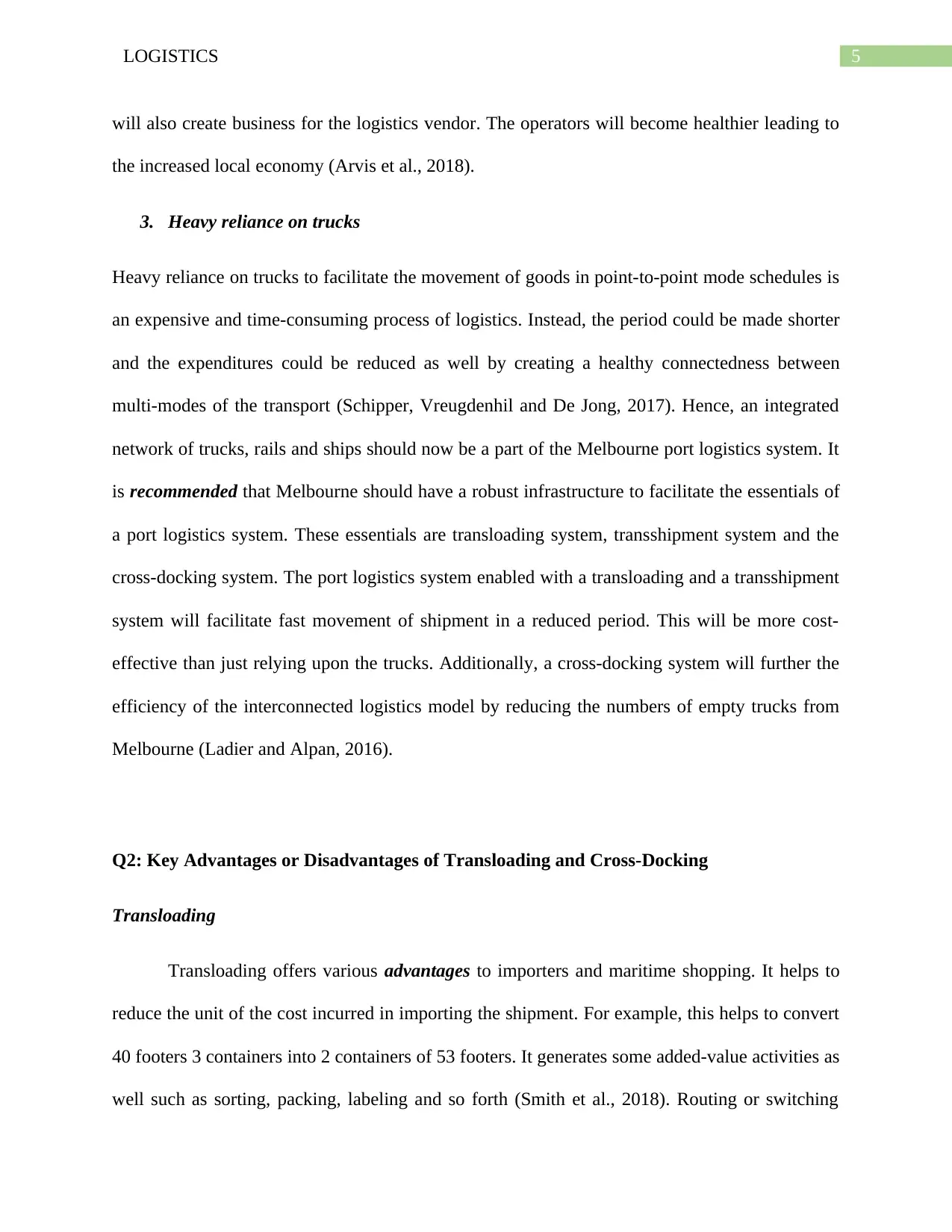
5LOGISTICS
will also create business for the logistics vendor. The operators will become healthier leading to
the increased local economy (Arvis et al., 2018).
3. Heavy reliance on trucks
Heavy reliance on trucks to facilitate the movement of goods in point-to-point mode schedules is
an expensive and time-consuming process of logistics. Instead, the period could be made shorter
and the expenditures could be reduced as well by creating a healthy connectedness between
multi-modes of the transport (Schipper, Vreugdenhil and De Jong, 2017). Hence, an integrated
network of trucks, rails and ships should now be a part of the Melbourne port logistics system. It
is recommended that Melbourne should have a robust infrastructure to facilitate the essentials of
a port logistics system. These essentials are transloading system, transshipment system and the
cross-docking system. The port logistics system enabled with a transloading and a transshipment
system will facilitate fast movement of shipment in a reduced period. This will be more cost-
effective than just relying upon the trucks. Additionally, a cross-docking system will further the
efficiency of the interconnected logistics model by reducing the numbers of empty trucks from
Melbourne (Ladier and Alpan, 2016).
Q2: Key Advantages or Disadvantages of Transloading and Cross-Docking
Transloading
Transloading offers various advantages to importers and maritime shopping. It helps to
reduce the unit of the cost incurred in importing the shipment. For example, this helps to convert
40 footers 3 containers into 2 containers of 53 footers. It generates some added-value activities as
well such as sorting, packing, labeling and so forth (Smith et al., 2018). Routing or switching
will also create business for the logistics vendor. The operators will become healthier leading to
the increased local economy (Arvis et al., 2018).
3. Heavy reliance on trucks
Heavy reliance on trucks to facilitate the movement of goods in point-to-point mode schedules is
an expensive and time-consuming process of logistics. Instead, the period could be made shorter
and the expenditures could be reduced as well by creating a healthy connectedness between
multi-modes of the transport (Schipper, Vreugdenhil and De Jong, 2017). Hence, an integrated
network of trucks, rails and ships should now be a part of the Melbourne port logistics system. It
is recommended that Melbourne should have a robust infrastructure to facilitate the essentials of
a port logistics system. These essentials are transloading system, transshipment system and the
cross-docking system. The port logistics system enabled with a transloading and a transshipment
system will facilitate fast movement of shipment in a reduced period. This will be more cost-
effective than just relying upon the trucks. Additionally, a cross-docking system will further the
efficiency of the interconnected logistics model by reducing the numbers of empty trucks from
Melbourne (Ladier and Alpan, 2016).
Q2: Key Advantages or Disadvantages of Transloading and Cross-Docking
Transloading
Transloading offers various advantages to importers and maritime shopping. It helps to
reduce the unit of the cost incurred in importing the shipment. For example, this helps to convert
40 footers 3 containers into 2 containers of 53 footers. It generates some added-value activities as
well such as sorting, packing, labeling and so forth (Smith et al., 2018). Routing or switching
⊘ This is a preview!⊘
Do you want full access?
Subscribe today to unlock all pages.

Trusted by 1+ million students worldwide
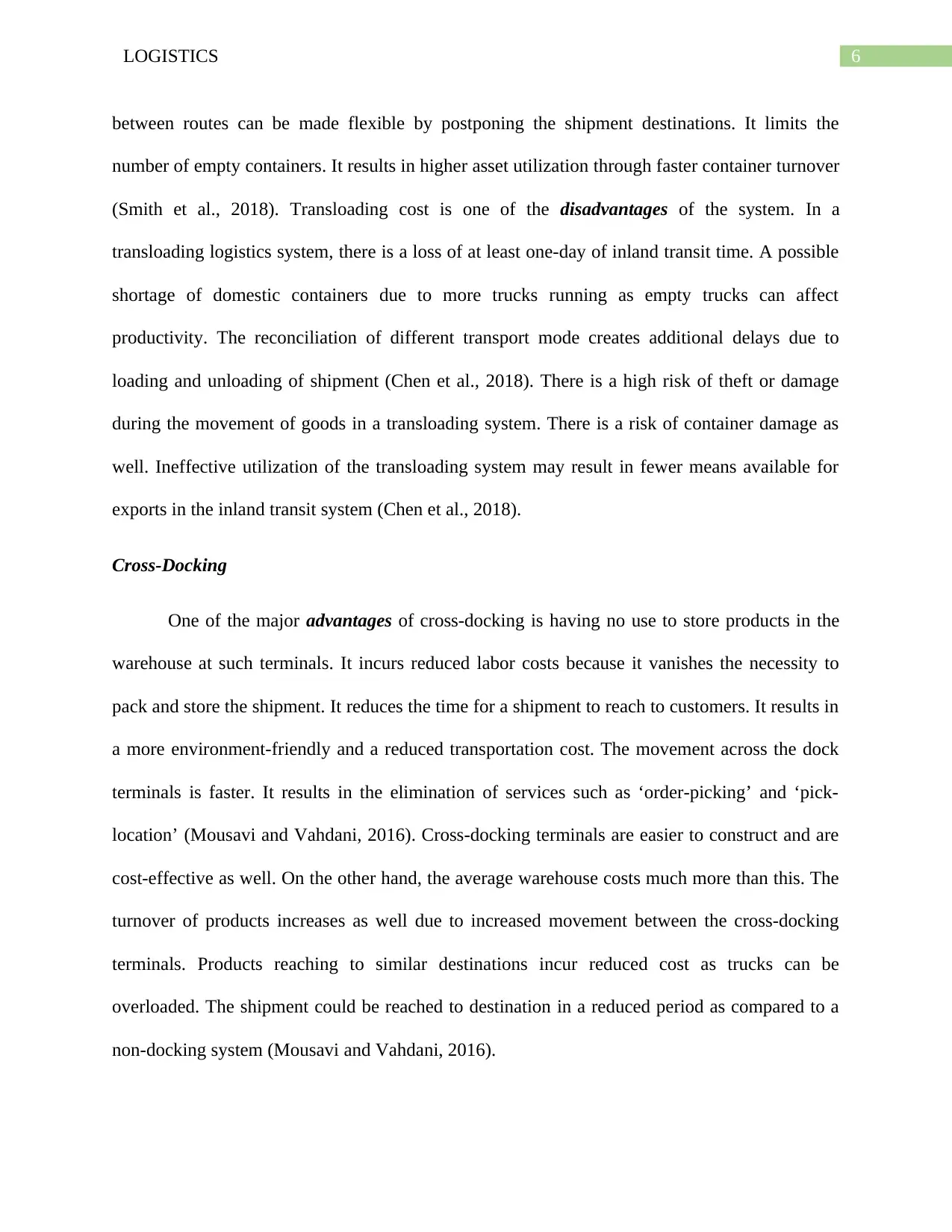
6LOGISTICS
between routes can be made flexible by postponing the shipment destinations. It limits the
number of empty containers. It results in higher asset utilization through faster container turnover
(Smith et al., 2018). Transloading cost is one of the disadvantages of the system. In a
transloading logistics system, there is a loss of at least one-day of inland transit time. A possible
shortage of domestic containers due to more trucks running as empty trucks can affect
productivity. The reconciliation of different transport mode creates additional delays due to
loading and unloading of shipment (Chen et al., 2018). There is a high risk of theft or damage
during the movement of goods in a transloading system. There is a risk of container damage as
well. Ineffective utilization of the transloading system may result in fewer means available for
exports in the inland transit system (Chen et al., 2018).
Cross-Docking
One of the major advantages of cross-docking is having no use to store products in the
warehouse at such terminals. It incurs reduced labor costs because it vanishes the necessity to
pack and store the shipment. It reduces the time for a shipment to reach to customers. It results in
a more environment-friendly and a reduced transportation cost. The movement across the dock
terminals is faster. It results in the elimination of services such as ‘order-picking’ and ‘pick-
location’ (Mousavi and Vahdani, 2016). Cross-docking terminals are easier to construct and are
cost-effective as well. On the other hand, the average warehouse costs much more than this. The
turnover of products increases as well due to increased movement between the cross-docking
terminals. Products reaching to similar destinations incur reduced cost as trucks can be
overloaded. The shipment could be reached to destination in a reduced period as compared to a
non-docking system (Mousavi and Vahdani, 2016).
between routes can be made flexible by postponing the shipment destinations. It limits the
number of empty containers. It results in higher asset utilization through faster container turnover
(Smith et al., 2018). Transloading cost is one of the disadvantages of the system. In a
transloading logistics system, there is a loss of at least one-day of inland transit time. A possible
shortage of domestic containers due to more trucks running as empty trucks can affect
productivity. The reconciliation of different transport mode creates additional delays due to
loading and unloading of shipment (Chen et al., 2018). There is a high risk of theft or damage
during the movement of goods in a transloading system. There is a risk of container damage as
well. Ineffective utilization of the transloading system may result in fewer means available for
exports in the inland transit system (Chen et al., 2018).
Cross-Docking
One of the major advantages of cross-docking is having no use to store products in the
warehouse at such terminals. It incurs reduced labor costs because it vanishes the necessity to
pack and store the shipment. It reduces the time for a shipment to reach to customers. It results in
a more environment-friendly and a reduced transportation cost. The movement across the dock
terminals is faster. It results in the elimination of services such as ‘order-picking’ and ‘pick-
location’ (Mousavi and Vahdani, 2016). Cross-docking terminals are easier to construct and are
cost-effective as well. On the other hand, the average warehouse costs much more than this. The
turnover of products increases as well due to increased movement between the cross-docking
terminals. Products reaching to similar destinations incur reduced cost as trucks can be
overloaded. The shipment could be reached to destination in a reduced period as compared to a
non-docking system (Mousavi and Vahdani, 2016).
Paraphrase This Document
Need a fresh take? Get an instant paraphrase of this document with our AI Paraphraser
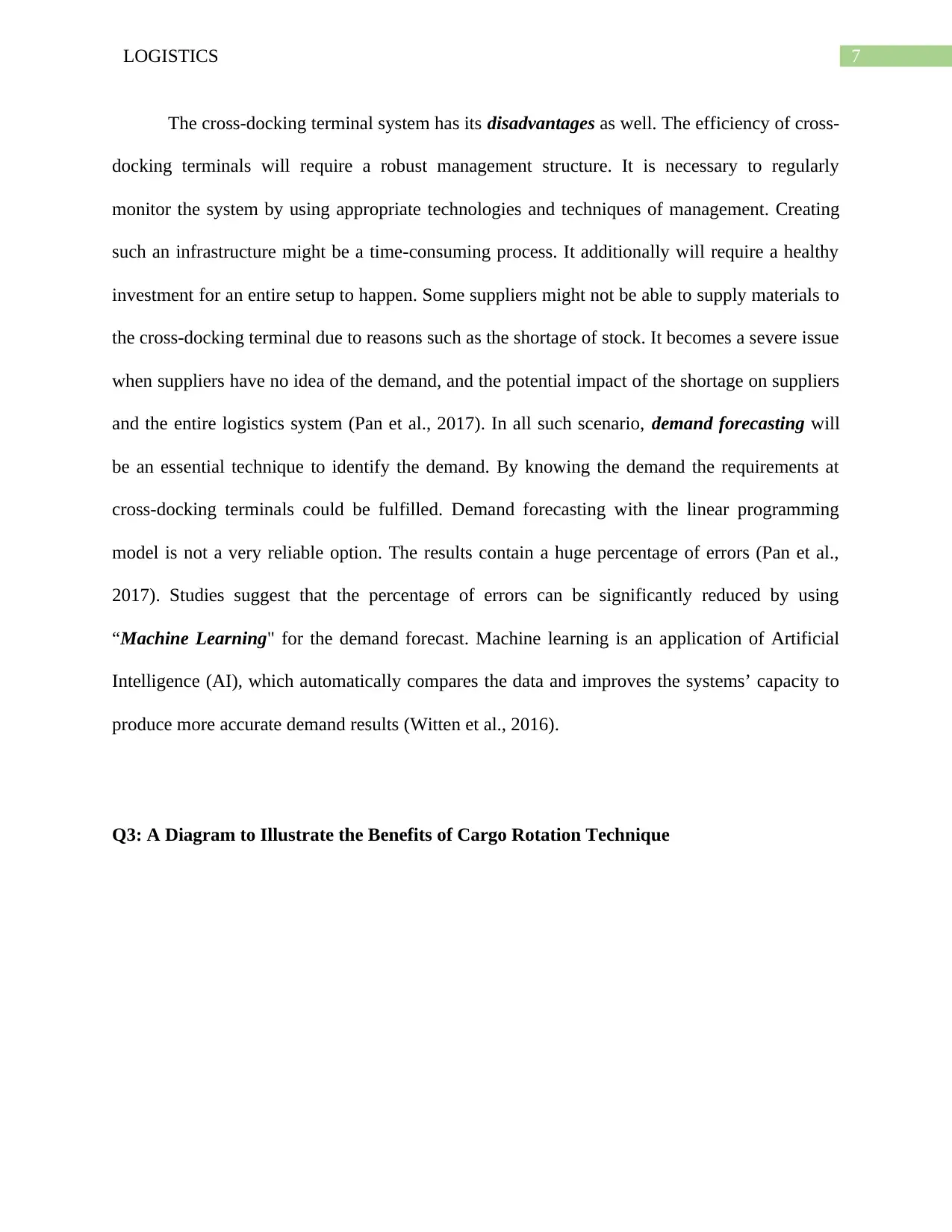
7LOGISTICS
The cross-docking terminal system has its disadvantages as well. The efficiency of cross-
docking terminals will require a robust management structure. It is necessary to regularly
monitor the system by using appropriate technologies and techniques of management. Creating
such an infrastructure might be a time-consuming process. It additionally will require a healthy
investment for an entire setup to happen. Some suppliers might not be able to supply materials to
the cross-docking terminal due to reasons such as the shortage of stock. It becomes a severe issue
when suppliers have no idea of the demand, and the potential impact of the shortage on suppliers
and the entire logistics system (Pan et al., 2017). In all such scenario, demand forecasting will
be an essential technique to identify the demand. By knowing the demand the requirements at
cross-docking terminals could be fulfilled. Demand forecasting with the linear programming
model is not a very reliable option. The results contain a huge percentage of errors (Pan et al.,
2017). Studies suggest that the percentage of errors can be significantly reduced by using
“Machine Learning" for the demand forecast. Machine learning is an application of Artificial
Intelligence (AI), which automatically compares the data and improves the systems’ capacity to
produce more accurate demand results (Witten et al., 2016).
Q3: A Diagram to Illustrate the Benefits of Cargo Rotation Technique
The cross-docking terminal system has its disadvantages as well. The efficiency of cross-
docking terminals will require a robust management structure. It is necessary to regularly
monitor the system by using appropriate technologies and techniques of management. Creating
such an infrastructure might be a time-consuming process. It additionally will require a healthy
investment for an entire setup to happen. Some suppliers might not be able to supply materials to
the cross-docking terminal due to reasons such as the shortage of stock. It becomes a severe issue
when suppliers have no idea of the demand, and the potential impact of the shortage on suppliers
and the entire logistics system (Pan et al., 2017). In all such scenario, demand forecasting will
be an essential technique to identify the demand. By knowing the demand the requirements at
cross-docking terminals could be fulfilled. Demand forecasting with the linear programming
model is not a very reliable option. The results contain a huge percentage of errors (Pan et al.,
2017). Studies suggest that the percentage of errors can be significantly reduced by using
“Machine Learning" for the demand forecast. Machine learning is an application of Artificial
Intelligence (AI), which automatically compares the data and improves the systems’ capacity to
produce more accurate demand results (Witten et al., 2016).
Q3: A Diagram to Illustrate the Benefits of Cargo Rotation Technique
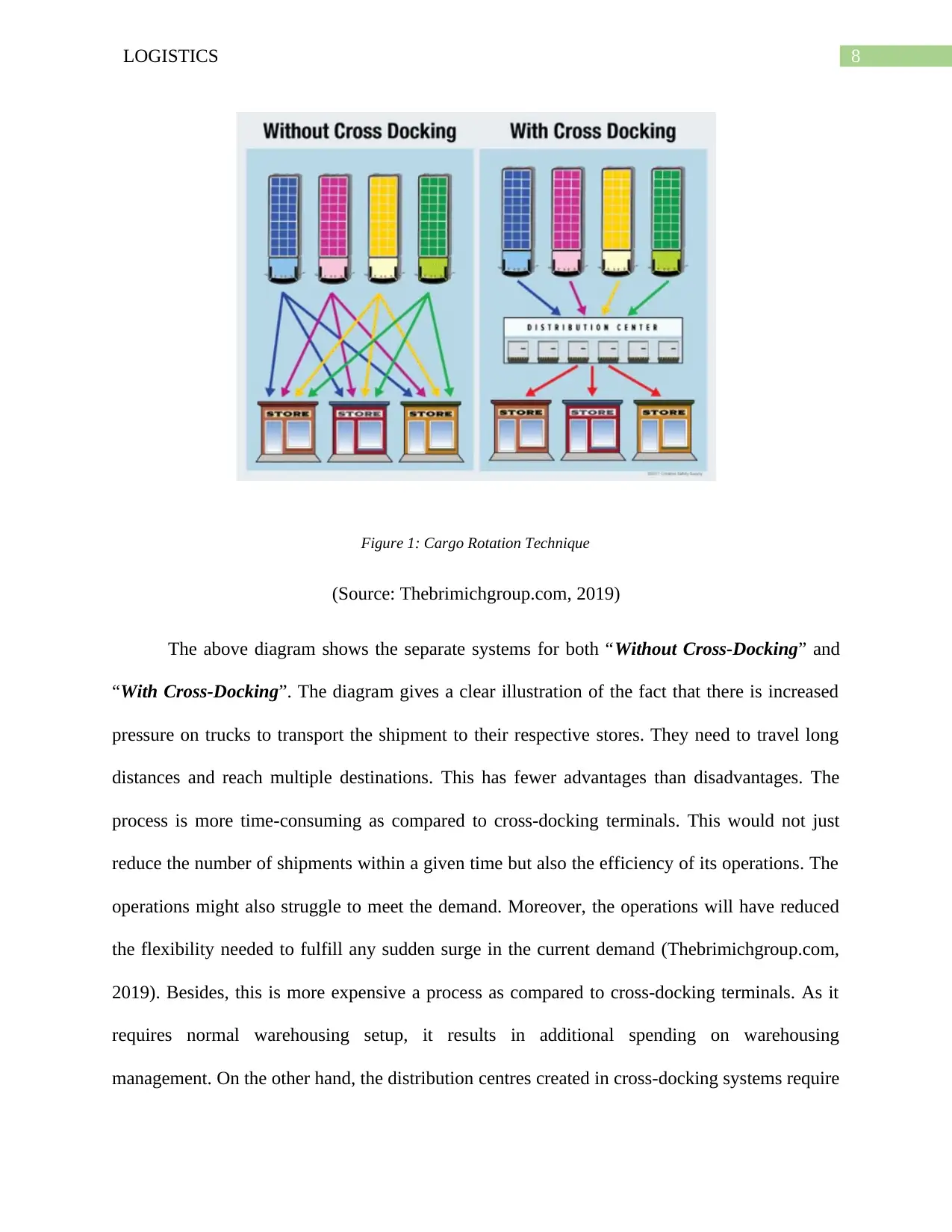
8LOGISTICS
Figure 1: Cargo Rotation Technique
(Source: Thebrimichgroup.com, 2019)
The above diagram shows the separate systems for both “Without Cross-Docking” and
“With Cross-Docking”. The diagram gives a clear illustration of the fact that there is increased
pressure on trucks to transport the shipment to their respective stores. They need to travel long
distances and reach multiple destinations. This has fewer advantages than disadvantages. The
process is more time-consuming as compared to cross-docking terminals. This would not just
reduce the number of shipments within a given time but also the efficiency of its operations. The
operations might also struggle to meet the demand. Moreover, the operations will have reduced
the flexibility needed to fulfill any sudden surge in the current demand (Thebrimichgroup.com,
2019). Besides, this is more expensive a process as compared to cross-docking terminals. As it
requires normal warehousing setup, it results in additional spending on warehousing
management. On the other hand, the distribution centres created in cross-docking systems require
Figure 1: Cargo Rotation Technique
(Source: Thebrimichgroup.com, 2019)
The above diagram shows the separate systems for both “Without Cross-Docking” and
“With Cross-Docking”. The diagram gives a clear illustration of the fact that there is increased
pressure on trucks to transport the shipment to their respective stores. They need to travel long
distances and reach multiple destinations. This has fewer advantages than disadvantages. The
process is more time-consuming as compared to cross-docking terminals. This would not just
reduce the number of shipments within a given time but also the efficiency of its operations. The
operations might also struggle to meet the demand. Moreover, the operations will have reduced
the flexibility needed to fulfill any sudden surge in the current demand (Thebrimichgroup.com,
2019). Besides, this is more expensive a process as compared to cross-docking terminals. As it
requires normal warehousing setup, it results in additional spending on warehousing
management. On the other hand, the distribution centres created in cross-docking systems require
⊘ This is a preview!⊘
Do you want full access?
Subscribe today to unlock all pages.

Trusted by 1+ million students worldwide
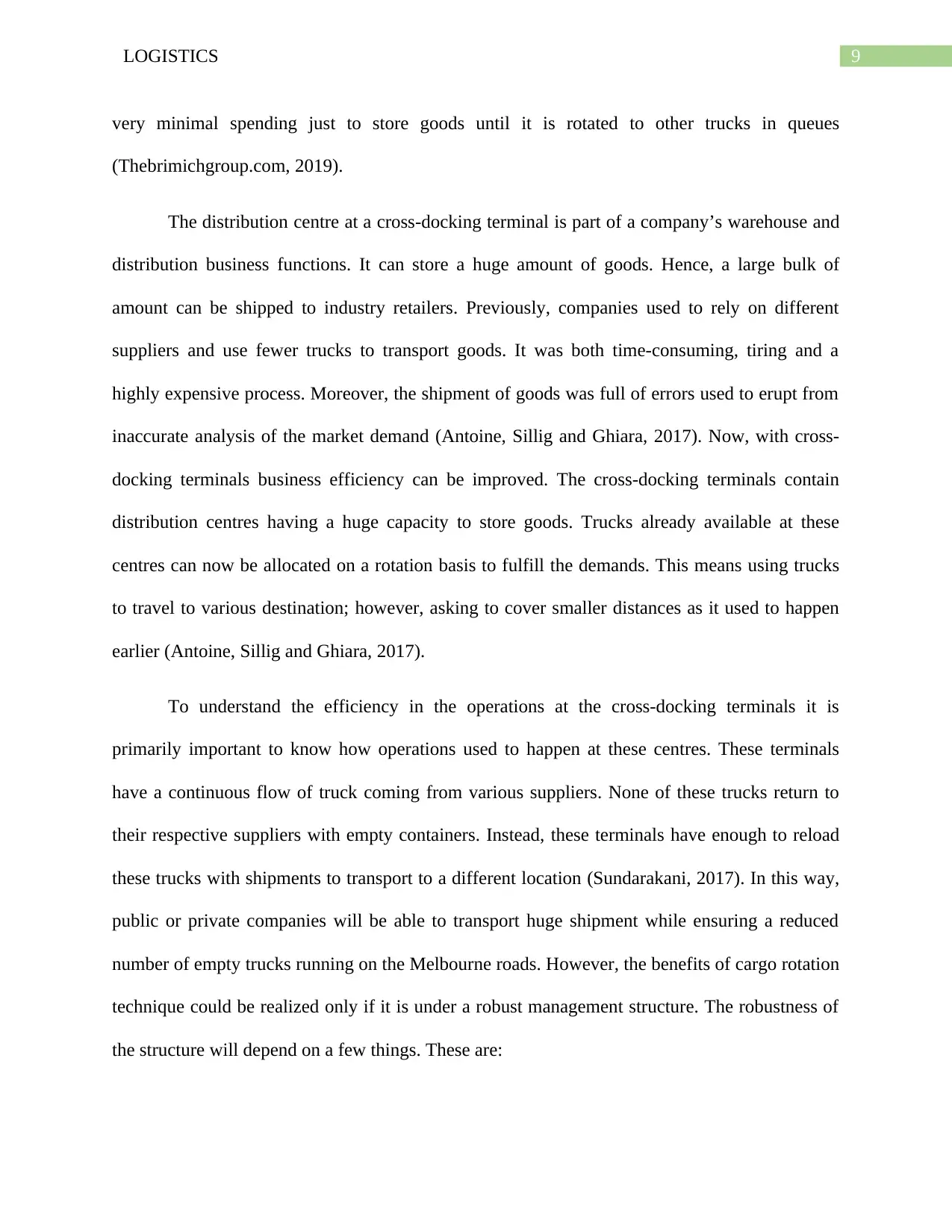
9LOGISTICS
very minimal spending just to store goods until it is rotated to other trucks in queues
(Thebrimichgroup.com, 2019).
The distribution centre at a cross-docking terminal is part of a company’s warehouse and
distribution business functions. It can store a huge amount of goods. Hence, a large bulk of
amount can be shipped to industry retailers. Previously, companies used to rely on different
suppliers and use fewer trucks to transport goods. It was both time-consuming, tiring and a
highly expensive process. Moreover, the shipment of goods was full of errors used to erupt from
inaccurate analysis of the market demand (Antoine, Sillig and Ghiara, 2017). Now, with cross-
docking terminals business efficiency can be improved. The cross-docking terminals contain
distribution centres having a huge capacity to store goods. Trucks already available at these
centres can now be allocated on a rotation basis to fulfill the demands. This means using trucks
to travel to various destination; however, asking to cover smaller distances as it used to happen
earlier (Antoine, Sillig and Ghiara, 2017).
To understand the efficiency in the operations at the cross-docking terminals it is
primarily important to know how operations used to happen at these centres. These terminals
have a continuous flow of truck coming from various suppliers. None of these trucks return to
their respective suppliers with empty containers. Instead, these terminals have enough to reload
these trucks with shipments to transport to a different location (Sundarakani, 2017). In this way,
public or private companies will be able to transport huge shipment while ensuring a reduced
number of empty trucks running on the Melbourne roads. However, the benefits of cargo rotation
technique could be realized only if it is under a robust management structure. The robustness of
the structure will depend on a few things. These are:
very minimal spending just to store goods until it is rotated to other trucks in queues
(Thebrimichgroup.com, 2019).
The distribution centre at a cross-docking terminal is part of a company’s warehouse and
distribution business functions. It can store a huge amount of goods. Hence, a large bulk of
amount can be shipped to industry retailers. Previously, companies used to rely on different
suppliers and use fewer trucks to transport goods. It was both time-consuming, tiring and a
highly expensive process. Moreover, the shipment of goods was full of errors used to erupt from
inaccurate analysis of the market demand (Antoine, Sillig and Ghiara, 2017). Now, with cross-
docking terminals business efficiency can be improved. The cross-docking terminals contain
distribution centres having a huge capacity to store goods. Trucks already available at these
centres can now be allocated on a rotation basis to fulfill the demands. This means using trucks
to travel to various destination; however, asking to cover smaller distances as it used to happen
earlier (Antoine, Sillig and Ghiara, 2017).
To understand the efficiency in the operations at the cross-docking terminals it is
primarily important to know how operations used to happen at these centres. These terminals
have a continuous flow of truck coming from various suppliers. None of these trucks return to
their respective suppliers with empty containers. Instead, these terminals have enough to reload
these trucks with shipments to transport to a different location (Sundarakani, 2017). In this way,
public or private companies will be able to transport huge shipment while ensuring a reduced
number of empty trucks running on the Melbourne roads. However, the benefits of cargo rotation
technique could be realized only if it is under a robust management structure. The robustness of
the structure will depend on a few things. These are:
Paraphrase This Document
Need a fresh take? Get an instant paraphrase of this document with our AI Paraphraser
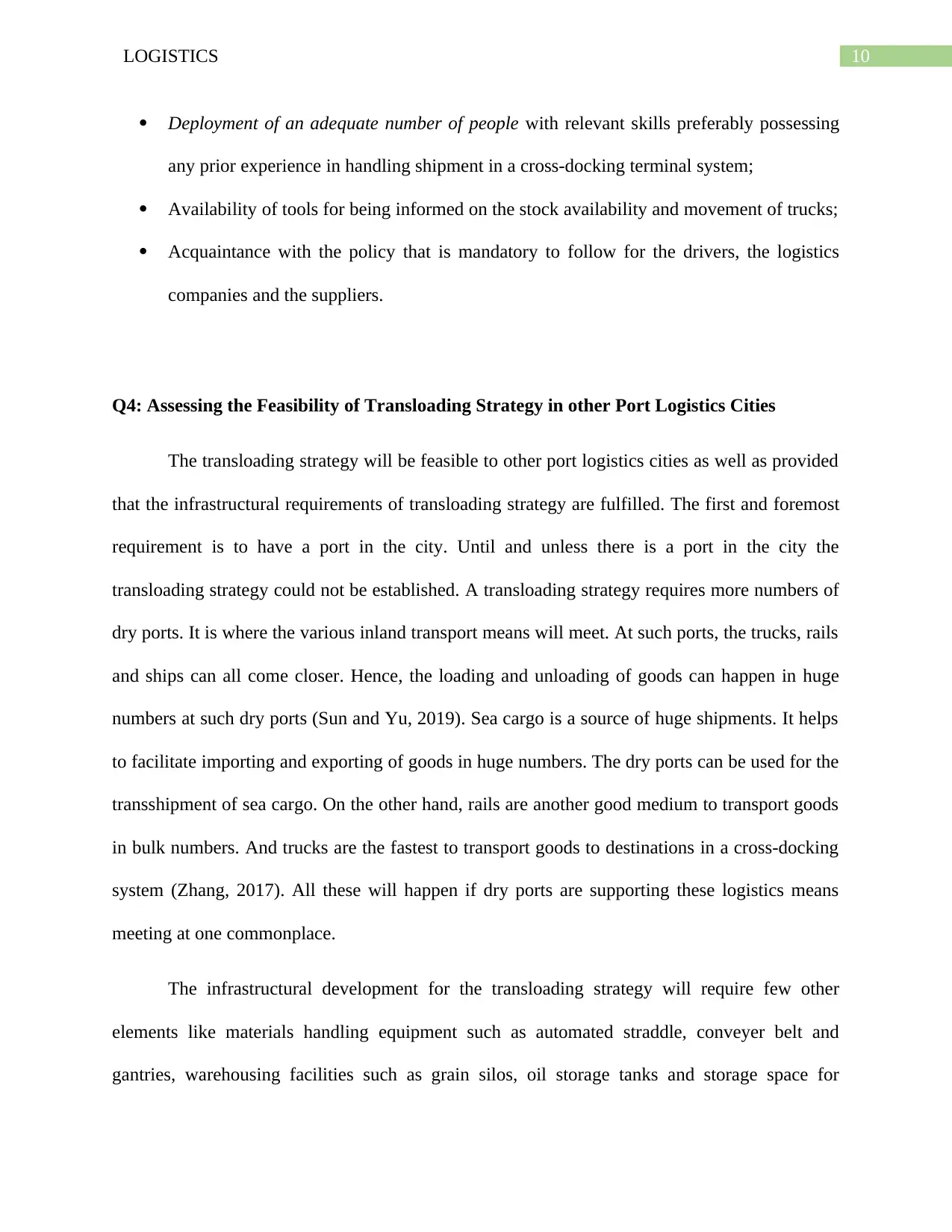
10LOGISTICS
Deployment of an adequate number of people with relevant skills preferably possessing
any prior experience in handling shipment in a cross-docking terminal system;
Availability of tools for being informed on the stock availability and movement of trucks;
Acquaintance with the policy that is mandatory to follow for the drivers, the logistics
companies and the suppliers.
Q4: Assessing the Feasibility of Transloading Strategy in other Port Logistics Cities
The transloading strategy will be feasible to other port logistics cities as well as provided
that the infrastructural requirements of transloading strategy are fulfilled. The first and foremost
requirement is to have a port in the city. Until and unless there is a port in the city the
transloading strategy could not be established. A transloading strategy requires more numbers of
dry ports. It is where the various inland transport means will meet. At such ports, the trucks, rails
and ships can all come closer. Hence, the loading and unloading of goods can happen in huge
numbers at such dry ports (Sun and Yu, 2019). Sea cargo is a source of huge shipments. It helps
to facilitate importing and exporting of goods in huge numbers. The dry ports can be used for the
transshipment of sea cargo. On the other hand, rails are another good medium to transport goods
in bulk numbers. And trucks are the fastest to transport goods to destinations in a cross-docking
system (Zhang, 2017). All these will happen if dry ports are supporting these logistics means
meeting at one commonplace.
The infrastructural development for the transloading strategy will require few other
elements like materials handling equipment such as automated straddle, conveyer belt and
gantries, warehousing facilities such as grain silos, oil storage tanks and storage space for
Deployment of an adequate number of people with relevant skills preferably possessing
any prior experience in handling shipment in a cross-docking terminal system;
Availability of tools for being informed on the stock availability and movement of trucks;
Acquaintance with the policy that is mandatory to follow for the drivers, the logistics
companies and the suppliers.
Q4: Assessing the Feasibility of Transloading Strategy in other Port Logistics Cities
The transloading strategy will be feasible to other port logistics cities as well as provided
that the infrastructural requirements of transloading strategy are fulfilled. The first and foremost
requirement is to have a port in the city. Until and unless there is a port in the city the
transloading strategy could not be established. A transloading strategy requires more numbers of
dry ports. It is where the various inland transport means will meet. At such ports, the trucks, rails
and ships can all come closer. Hence, the loading and unloading of goods can happen in huge
numbers at such dry ports (Sun and Yu, 2019). Sea cargo is a source of huge shipments. It helps
to facilitate importing and exporting of goods in huge numbers. The dry ports can be used for the
transshipment of sea cargo. On the other hand, rails are another good medium to transport goods
in bulk numbers. And trucks are the fastest to transport goods to destinations in a cross-docking
system (Zhang, 2017). All these will happen if dry ports are supporting these logistics means
meeting at one commonplace.
The infrastructural development for the transloading strategy will require few other
elements like materials handling equipment such as automated straddle, conveyer belt and
gantries, warehousing facilities such as grain silos, oil storage tanks and storage space for
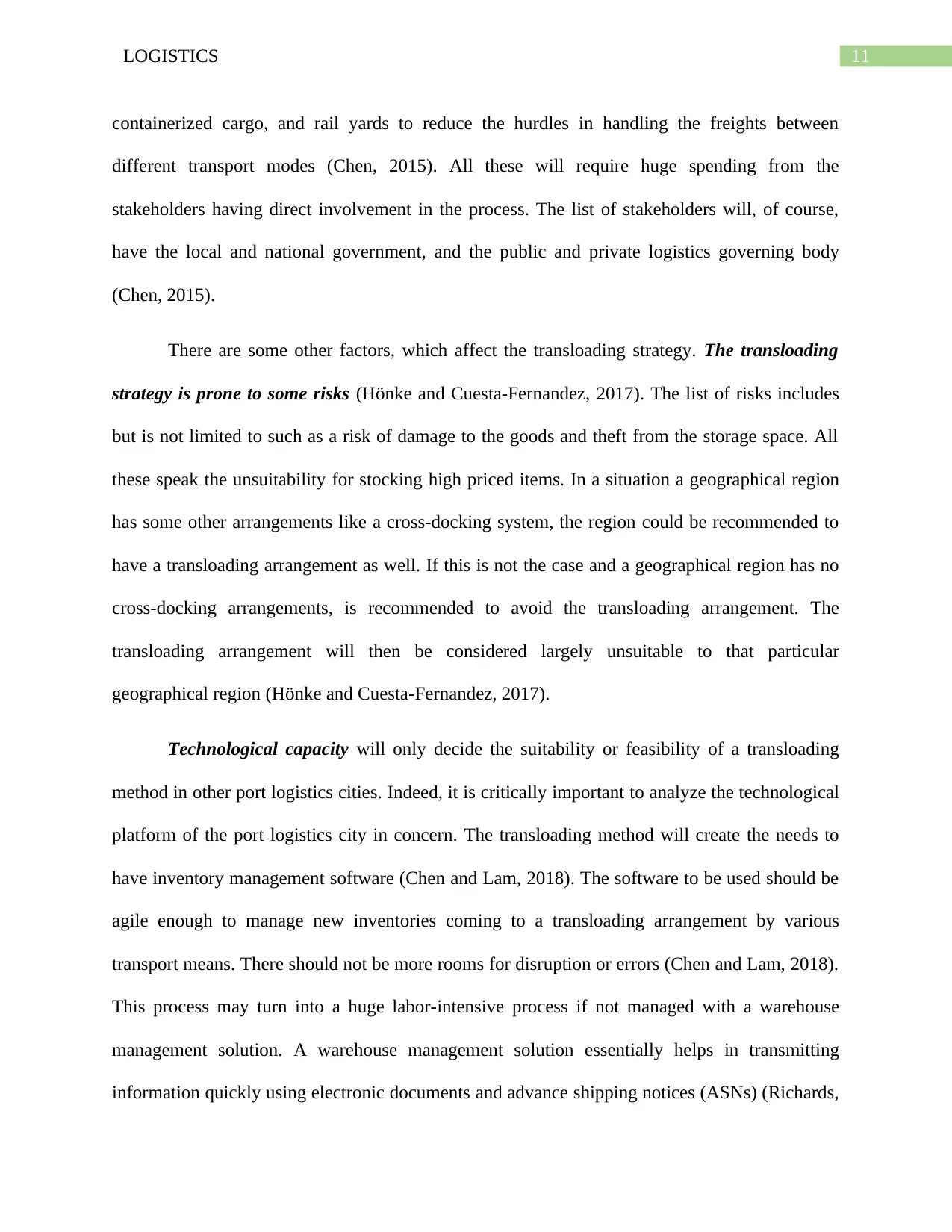
11LOGISTICS
containerized cargo, and rail yards to reduce the hurdles in handling the freights between
different transport modes (Chen, 2015). All these will require huge spending from the
stakeholders having direct involvement in the process. The list of stakeholders will, of course,
have the local and national government, and the public and private logistics governing body
(Chen, 2015).
There are some other factors, which affect the transloading strategy. The transloading
strategy is prone to some risks (Hönke and Cuesta-Fernandez, 2017). The list of risks includes
but is not limited to such as a risk of damage to the goods and theft from the storage space. All
these speak the unsuitability for stocking high priced items. In a situation a geographical region
has some other arrangements like a cross-docking system, the region could be recommended to
have a transloading arrangement as well. If this is not the case and a geographical region has no
cross-docking arrangements, is recommended to avoid the transloading arrangement. The
transloading arrangement will then be considered largely unsuitable to that particular
geographical region (Hönke and Cuesta-Fernandez, 2017).
Technological capacity will only decide the suitability or feasibility of a transloading
method in other port logistics cities. Indeed, it is critically important to analyze the technological
platform of the port logistics city in concern. The transloading method will create the needs to
have inventory management software (Chen and Lam, 2018). The software to be used should be
agile enough to manage new inventories coming to a transloading arrangement by various
transport means. There should not be more rooms for disruption or errors (Chen and Lam, 2018).
This process may turn into a huge labor-intensive process if not managed with a warehouse
management solution. A warehouse management solution essentially helps in transmitting
information quickly using electronic documents and advance shipping notices (ASNs) (Richards,
containerized cargo, and rail yards to reduce the hurdles in handling the freights between
different transport modes (Chen, 2015). All these will require huge spending from the
stakeholders having direct involvement in the process. The list of stakeholders will, of course,
have the local and national government, and the public and private logistics governing body
(Chen, 2015).
There are some other factors, which affect the transloading strategy. The transloading
strategy is prone to some risks (Hönke and Cuesta-Fernandez, 2017). The list of risks includes
but is not limited to such as a risk of damage to the goods and theft from the storage space. All
these speak the unsuitability for stocking high priced items. In a situation a geographical region
has some other arrangements like a cross-docking system, the region could be recommended to
have a transloading arrangement as well. If this is not the case and a geographical region has no
cross-docking arrangements, is recommended to avoid the transloading arrangement. The
transloading arrangement will then be considered largely unsuitable to that particular
geographical region (Hönke and Cuesta-Fernandez, 2017).
Technological capacity will only decide the suitability or feasibility of a transloading
method in other port logistics cities. Indeed, it is critically important to analyze the technological
platform of the port logistics city in concern. The transloading method will create the needs to
have inventory management software (Chen and Lam, 2018). The software to be used should be
agile enough to manage new inventories coming to a transloading arrangement by various
transport means. There should not be more rooms for disruption or errors (Chen and Lam, 2018).
This process may turn into a huge labor-intensive process if not managed with a warehouse
management solution. A warehouse management solution essentially helps in transmitting
information quickly using electronic documents and advance shipping notices (ASNs) (Richards,
⊘ This is a preview!⊘
Do you want full access?
Subscribe today to unlock all pages.

Trusted by 1+ million students worldwide
1 out of 16
Related Documents
Your All-in-One AI-Powered Toolkit for Academic Success.
+13062052269
info@desklib.com
Available 24*7 on WhatsApp / Email
![[object Object]](/_next/static/media/star-bottom.7253800d.svg)
Unlock your academic potential
Copyright © 2020–2025 A2Z Services. All Rights Reserved. Developed and managed by ZUCOL.





